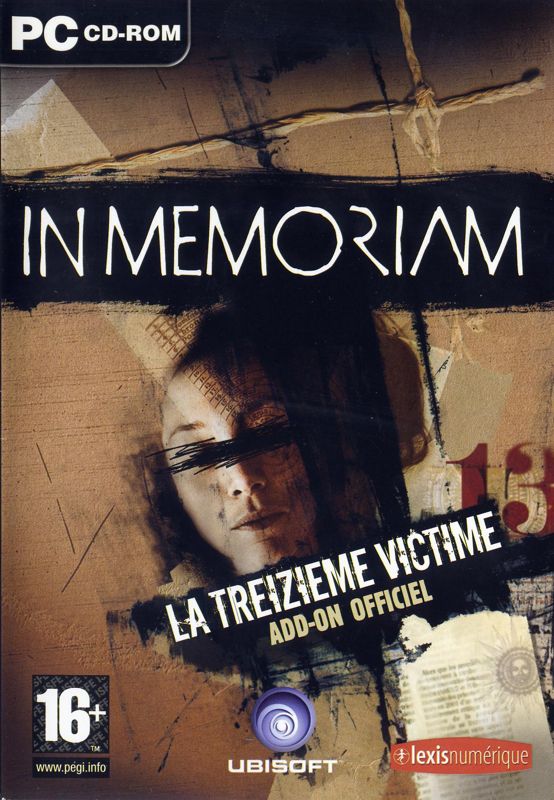Retro Replay Review
Gameplay
Missing: The 13th Victim delivers a deeply immersive investigative experience that builds on the foundations of the original MISSING game. Players are handed a CD-ROM packed with photos, video clips, audio snippets, e-mails and website printouts, all of which must be meticulously analyzed to track down the Phoenix before he strikes a thirteenth time. The real-time nature of sifting through clues creates genuine tension—every overlooked image or misheard whisper could mean another life lost.
(HEY YOU!! We hope you enjoy! We try not to run ads. So basically, this is a very expensive hobby running this site. Please consider joining us for updates, forums, and more. Network w/ us to make some cash or friends while retro gaming, and you can win some free retro games for posting. Okay, carry on 👍)
The user interface remains intuitive yet challenging. Tabs for video, audio, documents and external links are clearly labeled, and a built-in zoom tool helps you scour grainy stills for tiny details. While the navigation feels familiar to returning players, new tools like the waveform analyzer for audio clues and an enhanced timeline view for video footage ramp up the complexity. This expansion demands dedication: you’ll find yourself pausing mid-clip to freeze a frame or rewinding an audio file to catch subtle anomalies.
Puzzles are woven organically into the investigation, ranging from code-breaking mini-games to matching excerpts from Phoenix’s taunting e-mails with hidden web pages. None of the puzzles feel tacked on; each one unlocks a fresh piece of the killer’s pattern and pushes you closer to the final confrontation. For experienced mystery enthusiasts, the difficulty curve is well-judged—challenging enough to remain engaging, but never so obtuse that you feel completely stuck.
Graphics
Graphically, The 13th Victim leans into a gritty, low-res aesthetic that mirrors the era of mid-’90s CD-ROM adventures. While today’s gamers may balk at the occasional pixelation or monochrome security-cam shot, these qualities actually heighten the sense of authenticity. You get the feeling you’re rifling through a real detective’s case files, complete with fingerprints smudged across faded photographs.
Video sequences are grainy but atmospheric, often featuring shadow-laden alleys and dimly lit rooms that underscore the Phoenix’s morbid artistry. Close-up shots of crime scenes are deliberately unsettling: a pool of blood here, a cryptic symbol scrawled on a wall there. These visuals effectively stoke tension without ever veering into outright gore, maintaining a balance between suspense and restraint.
Even the mundane graphics – e-mail headers, website mockups, file directories – are thoughtfully designed. Each interface element feels part of a cohesive world, from the flickering “New Message” icon to the static-ridden webcam feeds. Although this expansion doesn’t push 3D rendering or high-definition textures, its deliberate stylistic choices serve the narrative superbly, making every clue feel hard-won and vital.
Story
Set one year after the notorious Lorski/Gijman case, The 13th Victim thrusts players back into the chilling mind of the Phoenix. This time, the killer has not only resurfaced but gone digital, announcing his return via a cryptic CD-ROM that teases a fresh wave of abductions and murders. Lives hang in the balance once more, and it’s up to you to decode his sadistic puzzles before it’s too late.
The narrative unfolds in real time as you piece together the Phoenix’s trail: a sinister collage of photos, intercepted audio messages and taunting emails. Each clue reveals a glimpse of his twisted psyche, from the arrogance in his voice recordings to the signature phoenix symbol scrawled on each crime scene. The interplay between his online communications and tangible evidence builds a palpable sense of dread with every new revelation.
Throughout the investigation, there’s a recurring theme of vengeance and rebirth that ties back to the Phoenix mythology. As you dig deeper, you discover that the killer’s motives are more than mere thrills—they’re a perverse commentary on justice, rebirth and unresolved trauma. The story’s layering of personal vendettas with grandiose symbolism keeps you hooked, ensuring that the final breakthrough delivers both closure and a haunting coda to the killer’s spree.
Overall Experience
Missing: The 13th Victim stands out as one of the more ambitious expansions in the crime-thriller genre. By requiring players to juggle multiple media types—photos, videos, websites, emails—it elevates the detective process into a multi-sensory experience. This isn’t a casual point-and-click affair; it demands patience, keen observation and a willingness to dive deep into the Phoenix’s twisted mind.
One caveat: you must own and have installed the original MISSING game. If you’re a newcomer, you’ll benefit from familiarizing yourself with the base mechanics and story background before tackling this expansion. However, for returning fans who relish incremental complexity and fresh narrative layers, The 13th Victim feels like a natural and worthwhile continuation.
Replay value is moderate but satisfying, especially if you missed minor clues on your first run. Hidden Easter eggs and alternate puzzle approaches encourage a second or even third playthrough. While the overall length is shorter than a full sequel, the tight focus on investigative depth makes every hour count.
Ultimately, The 13th Victim delivers a gripping, cerebral ride that will appeal most to mystery buffs and digital sleuths. It doesn’t rely on flashy graphics or action set-pieces; instead, it offers a methodical, tension-filled journey into the heart of darkness. If you’re ready to challenge your deduction skills and brace yourself for psychological thrills, this expansion is a worthy addition to your crime-adventure library.
 Retro Replay Retro Replay gaming reviews, news, emulation, geek stuff and more!
Retro Replay Retro Replay gaming reviews, news, emulation, geek stuff and more!




Reviews
There are no reviews yet.